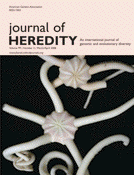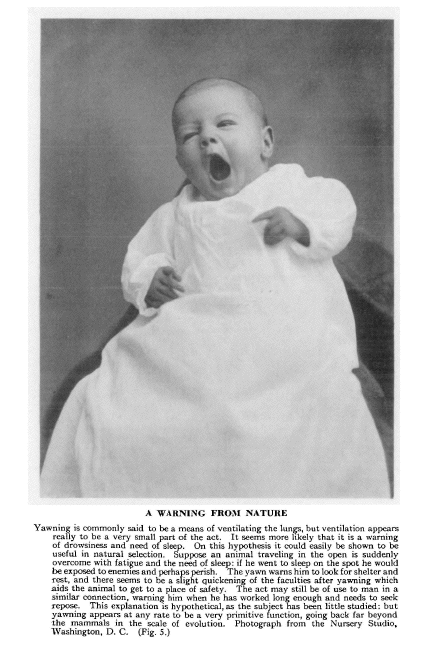 -
-
- YAWNING is commonly said to be a means of
ventilating the lungs when they need it.
Everyone knows that it is an involuntary act,
and often excited by seeing some one else yawn;
the real purpose of the act, however, has been
very little studied. Prof. F. H. Pike, of the
College of Physicians and Surgeons, Columbia
University, New York, was asked for his opinion
in regard to the evolutionary origin of yawning,
and has sent the following remarks, with a
warning that they are partly fact and partly
hypothesis.
-
- "Luciani in his
Human Physiology, vol. 1, p. 438, speaks of a
deep inspiration as a part of the general
process of yawning. He regards it as the
external expression of ennui, drowsiness,
hunger, and the like, but it does not seem to me
that the ventilation of the thorax is the
primary object of yawning. On our present views
of the nature of the stimulus to respiration,
the ventilation of the thorax keeps pace with
the changing hydrogen ion content of the blood.
An increase in the concentration of the hydrogen
ions is accompanied by an immediate increase in
the depth or rate of the respiratory movements.
There is normally a deeper inspiration than
usual occurring every few breaths, and it does
not seem probable that there is a sufficient
accumulation of carbon dioxide in the blood
under any ordinary conditions to require any
extreme effort such as yawning would indicate if
its main purpose were to ventilate the lungs. A
little vigorous exercise will remove the
immediate cause of yawning, but it will also
result in a greater ventilation of the thorax
and lungs than occurred during yawning.
-
- Muscular movements
-
- "Yawning, in a state of nature, involves
certain attendant movements and sounds that are
absent in the human subject, after a course in a
young ladies' finishing school or any similar
institution. The dog gives a sort of whine and
stretches his other muscles, particularly those
of the fore legs, as well as those of the head
and jaws. I am more and more inclined to regard
yawning as an expression of a state of
approaching fatigue, very much analogous to the
other stretching movements of muscles in
general. It may be a sort of involuntary
exercise to keep one awake until a safe place
for sleeping may be found. There is always a
little quickening of the faculties after a deep
yawn, and this is more pronounced if there is an
attendant stretching of the muscles. One might
imagine that the impulse to sleep might begin to
come upon an animal while still out in the open,
and that, if no warning sign were present, he
might lie down in the open and go to sleep in a
place exposed to attack from enemies. The
continued yawning may be sufficient to keep him
awake until he can reach a place of safety. This
particular kind of utility may be lacking in
civilized man, but the whole mechanism persists
unchanged. To a certain limited extent, yawning
might be regarded as a vestigal function if
regarded from this point of view alone. But
I am not sure that yawning has ceased to be
useful to civilized man. The onset of yawning
may interrupt a process which might otherwise be
carried to a harmful degree. A student begins to
yawn in the evening, and, unless he resorts to
some measures to overcome his drowsiness, the
interruption to his work is likely to become so
great that he seeks relief in sleep. If he
employ measures to drive away his drowsiness,
such as the use of strong coffee, a walk around
the block, or other similar things, he may be
able to go on working, but he is pretty certain
later on to feel, more severely than ever, the
effects of fatigue, and he may suffer great
injury if he persists too long in disregarding
these warning signs of nature.
-
- "I think Luciani is right in regarding
yawning as an expression of drowsiness, but I
believe also that too much emphasis has been
placed on the factor of ventilation of the
lungs. As a matter of fact, if one yawns widely,
there is a total cessation of the movements of
the thorax and diaphragm during the period when
the mouth is most widely open. This I attribute
to the stimulation of the endings of the
glossopharyngeal nerve in the pharynx and uvula
by the stretching of these portions of the
alimentary tract at that time. It is well known
that stimulation of the glossopharyngeal nerve
will stop all respiratory movements immediately.
Such a cessation normally occurs during
swallowing. At the moment anything touches the
uvula, respiration ceases immediately. One can
feel the stretching of the pillars of the fauces
and of the pharynx and uvula, or, more
correctly, the part of the soft palate
immediately to each side of the uvula, when the
mouth is widely open in yawning."
-
- Not only is yawning a very primitive
adaption (if, indeed, it be an adaptation) but
it appears to go back to a remote stage of
evolution, perhaps far below the age of mammals.
On this point Dr. Pike remarks:
-
- "In thinking over the matter superficially
it appears that the primitive respiratory
neuro-muscular mechanism is the part
particularly concerned. In fishes, the
respiratory system involves the musculature of
the mouth and possibly of the pharynx, and the
nerves concerned are the fifth, seventh, ninth,
tenth and twelfth cranial. The diaphragm and the
phrenic nerve have not yet made their
appearance, and the intercostal nerves and
muscles are not concerned in the respiratory
movements. That is what I mean by the primitive
neuro-muscular respiratory mechanism. The
muscles of the face and pharynx are involved in
yawning, and the fifth, ninth, tenth and twelfth
cranial nerves are also involved. I do not know
where in the animal scale yawning first appears,
but I should imagine that we might expect it in
all the mammals, and possibly in some of the
poikilothermal forms. It seems to be present in
birds. In some respects, it approaches the type
of respiration that is seen in cases of
approaching death. In such circumstances, we
have again the participation of the primitive
neuro-muscular respiratory mechanism. The mouth
is opened widely, often with a quivering or
unsteady movement, and the thorax does not
participate to the same extent as in normal
respiration. The movements of the thorax may
persist, altered in rhythm, to be sure, but
nevertheless present, during yawning. I think
that this is further evidence of the fact that
yawning is related to the primitive mechanism."

|


